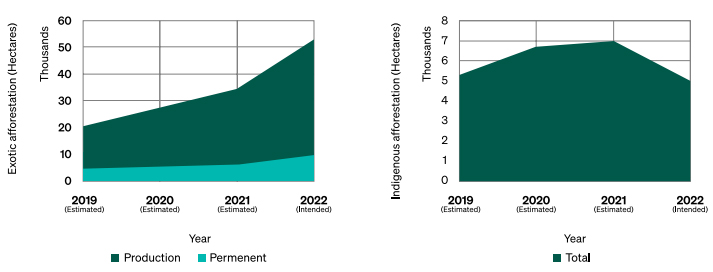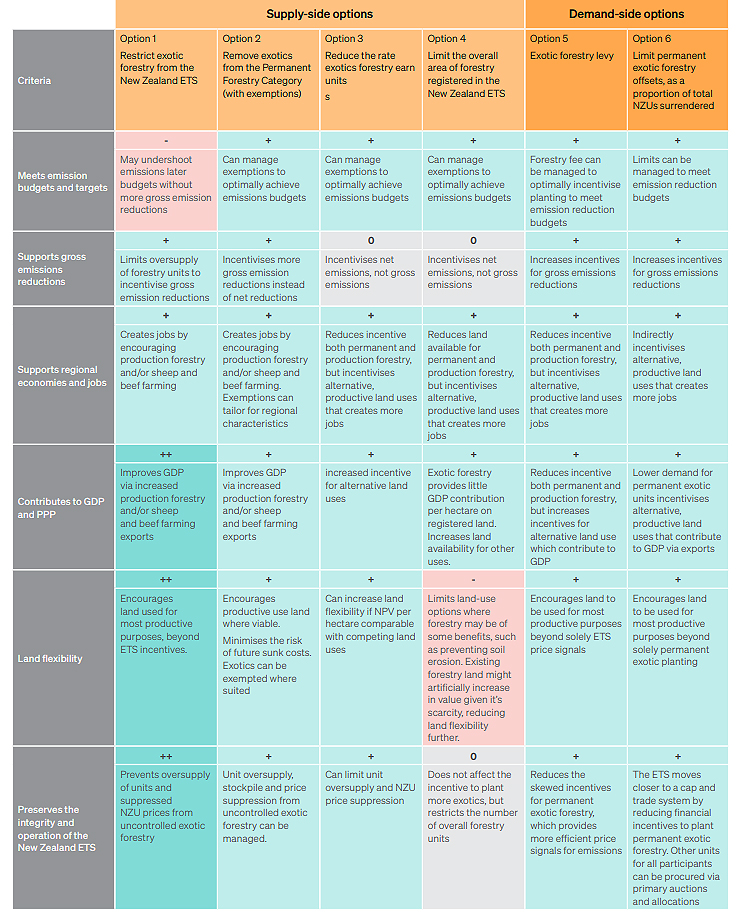
The issues around the Emissions Trading Scheme (ETS) and farmer have gone below the radar recently. Mostly overtaken by the rolling out of the various parties’ election policies and promises. However, Beef+Lamb NZ have (last week) released an updated report commissioned by them from law firm Meredith Connell (MC).
Although the document states that it is written “as the starting point for a national discussion on the role forestry offsets play in our country’s climate strategy”, it should perhaps be better considered as a ‘submission’ to MPI for the re-evaluation of the Permanent Forestry Category of the ETS programme. This was called for back in May and submissions have (as of last week) now closed.
Even the MC title “Planting out our rural communities? What is wrong with forestry offsets in the ETS and what needs to be done” leads the reader down this pathway. The timing of the government review is perhaps unfortunate as it is not likely that any real progress is going to be made this side of Christmas, given the upcoming election and even if Labour manage to get back in, it will be with a mix of absent current members and presumably some new faces.
As the report title indicates the focus is on the impact permanent (exotic) forests are having (or potentially having) on both rural communities and New Zealand food production base. It continues to show how out of step the New Zealand approach to using trees as offsets is with the vast majority of other countries. “Typically, participants (other countries) are restricted to offsetting no more than 10% of their gross emissions surrender obligations. In contrast, the primary purpose of the New Zealand ETS is to achieve net emissions reductions, allowing unlimited use of forestry units to meet surrender obligations”. To be fair to the government, (even) they have realised this now and the review has been to focus on better ways forward.
The B+LNZ report goes further than just looking at the problem, but also provides a range of potential solutions and picks what it believes are the ones more favoured to work.
The graph below shows MPI’s 2021 Survey of Afforestation Intentions which clearly shows the spike occurring post 2012 as the price of carbon increased and appears to be at the expense of indigenous forests.

The lifting of the cap on the ETS in 2019 was meant to discourage ‘polluters’ from emitting but in reality it just drove them to invest in offsets leading to what many on the land would believe is the worst of both worlds; still emitting and gobbling up land at the same time.
The graph does show that production planting has increased at a greater rate than ‘permanent’ but given that time will fudge this, many don’t believe these numbers correctly reflect what the real purpose of the plantings are for, but it will take 25 plus years to find out.
If they are truly production plantings then there is going to be a lot of timber to be milled from 2050 onwards and it also would mean that the more remote steeper country which maybe could benefit from permanent plantings will not be (assuming production plantings need to be within an economic hauling distance from ports or mills).
It is also worth mentioning that the 50,000ha being planted it is around double the area the Climate Change Commission estimated as being needed to reach “net zero emissions”. If this rate was to be achieved it also raises the question as to what would be the price for ETS credits. I presume exceeding net zero targets would mean the price could be significantly reduced from the predicted highs.
The B+LNZ report hopefully has finally put to bed the argument that forestry creates more jobs than existing on farms. The table below clearly shows the negative impact on employment and resulting downstream impact on rural communities

Source: B+LNZ report 2023
The report authors have proposed six potential ways forward of which four are on the supply side:
Option 1: Restrict exotic forestry in the New Zealand ETS
Option 2: Remove exotics from the Permanent Forestry Category (with exemptions)
Option 3: Reduce the rate at which exotic forestry earns NZUs
Option 4: Limit permanent exotic forestry by land area
And on the demand side:
Option 5: Permanent exotic forestry levy
Option 6: Limit permanent exotic forestry offsets, as a proportion of total NZUs surrendered
The table below lays out how they believe the different options compare to each other.

Source: B+LNZ report 2023
They have selected two options, one each from supply and demand as to how they see the way forward to be best served.
Option 2: Remove exotics from the Permanent Forestry Category (with exemptions); and
Option 6: Limit permanent exotic forestry offsets, as a proportion of total NZUs surrendered.
Whether ’hitting’ the issue with both barrels will mean that New Zealand fails to reach the number of hectares required to be planted to achieve ‘net zero’ largely depends upon how accurate the MPI Survey of Afforestation Intentions is. I tend to believe under the suggested settings a lot of those ‘production’ hectares may disappear into hot air. However, the report is an easy read with clear assumptions for most of their reasoning and will lend good information to the debate ahead.
In the meantime the government has maintained the settings on the next September ETS auction but has lifted them for the following December auction. The current price of trade NZ credits is in the graph below. As always, interesting time ahead.

Source: Jarden: CarbonNews
14 Comments
Guy, 2012 is not in the graphs , not sure if you mean 2020 or 2021?
I can think of some other solutions. One would be subsidising planting of natives , in existing permament exotic forests.quite a lot of work would be required, planting , pruning ,pest control, etc.What this would cost , and how this would be paid for is a question. I'm starting to think along the lines of a surcharge on the carbon credits , the govt buys all credits produced, and sells them at a higher price to emitters.
another is agroforestry, several exotics been able to store carbon , and produce fodded at the same time . E.g acorns form oak trees for pigs, poplar /willow/ paulowina/ tagaste for leaf fodder , several other exotics that produce leaf material or seedpods that are edible.
Is there really a 'forestry issue'? There is less exotic forest today than 20 years ago. Dairy conversion has shifted forestry off the plains. Rural job loss is more to do with mechanisation and efficiency than forestry conversion. Farmers' children are still going to school, they are just schools in different locations.
If exotic species are excluded from permanent forest, then the amount of area required for offset will increase by a factor of 10.
There is massive opportunity for an integrated production forestry industry, New Zealand has competitive advantages. The hurdle of course is capital investment.
Agree SimonP, it's quite simple really just zone permanent exotic forest to areas of steep grassland that is unsustainable to keep farming. Also there has to be good average rainfall and a native bush seed source nearby.
In such situations the transformation will naturally happen.
To suggest that we don't know what will happen after 20yrs in a pine forest is just wrong. Of course we know, there are plenty of pine forests unharvested well over 50yrs and the transformation to include native vegetation is absolutely evident.
To restrict farmers using poor areas of their land for exotic permanent forest for carbon income to support their business is very backward thinking by BLNZ.
Rather than buying carbon credits from other countries shouldn't NZ buy credits from within NZ. The money then stays in our local economy and supports NZ farming.
What silly stuff. Without forestry hill country farming has been in steady decline for decades and will continue to be going forward. Wool has no hope as costs rise and processing plants world wide age and are not being replaced - from my long time wool broking friends. Less and less labour available and more options for young people. Most farmers have sold as they have no succession plan, no real profit and no one wanting or able to buy a farm - this was the case before carbon prices rose as I bought farms then and it was embarrassing how many you could choose from. Carry on in Lala land blaming everyone one and everything but avoiding the hard facts and truths. There's only as much forest now as 20 years ago, just, and we may never harvest as much again as now with hard country being closed up. The market will sort this out as costs are up, all over the world, interest rates normal again, El Nino due - imagine what a large drought in Aus will do to the meat market with there current record flock numbers. This is simple maths really and all this commentary and reports demonstrate a complete lack of business accumum and ..well lack of any intellectual thought or ability to add. Good luck you will need huge amounts of it and by the way there is no such thing as luck.
I might add the job numbers are plain wrong. Ask BandL to show the report done on S Otago but never released - why because it showed forestry with as many if not more jobs and much higher pay - on timber alone. Again delusional manufacturing of numbers. Heck only 26% of farmers were making a profit at high prices - from their own industry numbers. Blind leading the blind over the cliff.
So if livestock farming starts paying for emissions, what will land owners actually earn a living from?
Beef and lamb seem hell bent on destroying land owner options!
As pointed out above, many want livestock to be a sunset industry. There's a lot of effort going into making it so.
Will the pine being planted ever be harvested? Most not, even high grade logs close to port, because export options have disappeared, probably permanently.




We welcome your comments below. If you are not already registered, please register to comment.
Remember we welcome robust, respectful and insightful debate. We don't welcome abusive or defamatory comments and will de-register those repeatedly making such comments. Our current comment policy is here.